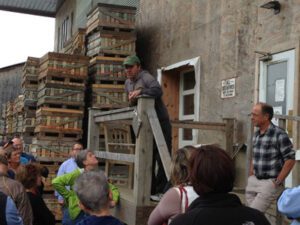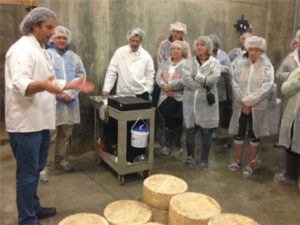
Last week, VCRD hosted a “State Rural Policy Innovation Roundtable” reviewing key rural development action led by states and how this work can contribute to national rural policy. We had folks from California, Wyoming, Oregon, Vermont, Illinois, Michigan, Maryland, Ohio, Virginia, Idaho, Arizona, Maine, Texas, Minnesota, Utah, Wisconsin, Indiana, North Carolina, Missouri, Pennsylvania, and Washington DC.
The Roundtable was a unique time for rural leaders from state rural development councils like VCRD to sit down with leaders from the national Rural Policy Research Institute (RUPRI) and their leadership team of State Rural Policy Centers and think broadly about how best to serve rural towns throughout the country.
Visitors heard a great deal about Vermont culture and all the things we are “first” in, from the first victory in the Revolutionary War (Ticonderoga) to food systems (first per capita in direct sales, farmers’ markets, CSAs, and organic farms) to the most ambitious state plan for clean energy development. They also heard that we have the best downtowns, the best food and the best beer. One visitor from Michigan remarked, “So this is where they sell all those Priuses.” Another made the joke (later repeated endlessly) that “Vermont is first per capita…in pride.”
We took the ribbing in good humor. The tables were turned when we took this diverse group on what we called the “Rural Renaissance Road Trip:” a bus tour of the Northeast Kingdom with stops at the Cellars at Jasper Hill, High Mowing Organic Seeds, Vermont Soy and Vermont Natural Coatings, The Center for an Agricultural Economy and VT Food Venture Center in Hardwick, Pete’s Greens, the NEK Tasting Center in Newport and to meet with the Newport Renaissance Corporation at the Gateway building on Lake Memphremagog.

Pete Johnson of Pete’s Greens talks to rural leaders from across the country.
We tired them right out.
While the day may have started with us bragging about the wonders of our fair state, it ended with our visitors praising what they had seen and heard.
They heard Andy Kehler at Jasper Hill describe how there are essentially three places in the world that maintain and develop microbial cheese cultures…and how Jasper Hill (with support from the Working Landscape Enterprise Board) would be the fourth, and how that would help make the NEK an international center of cheese development.
Andrew Meyer of Vermont Soy and Vermont Natural Coatings talked about how he didn’t want his businesses to grow out of the scale of his community, and how he worked collaboratively with other entrepreneurs through handshake deals to lend money or products or distribution to advance their common interests.
They had lunch at Claire’s with a tasting of Hill Farmstead beer. They heard Tom Stearns (High Mowing Organic Seeds), Sarah Waring (VT Food Venture Center), and then Pete Johnson (Pete’s Greens) talk about the structure of the food system and its capacity for regeneration of the land and community. They met Trish Sears of the Newport Renaissance Corporation and Eleanor Leger of Eden Ice Cider who has led in the development of the tasting center in Newport and the rebirth of that downtown.

Rural leaders learn about collaboration in dairy farming at Jasper Hill Cellars
It was amazing to us, who know these stories, to see the impression that they make on national leaders from other rural states. From the comments they made to us, I think it’s fair to say that they were terrifically inspired. Our visitors from across the country see rural towns that lose youth, that lose ambition and creativity, and that struggle to hold on to hope. It’s a danger here, too. But we are truly blessed in the innovators and leaders: the rock stars that are building a new rural economy. We are fortunate to attract and grow real heroes who are driving innovation forward in rural towns; innovation that fits our heritage, character and place. If not for them, we would be in real trouble.
Yeah, you bet we’re proud of Vermont.
